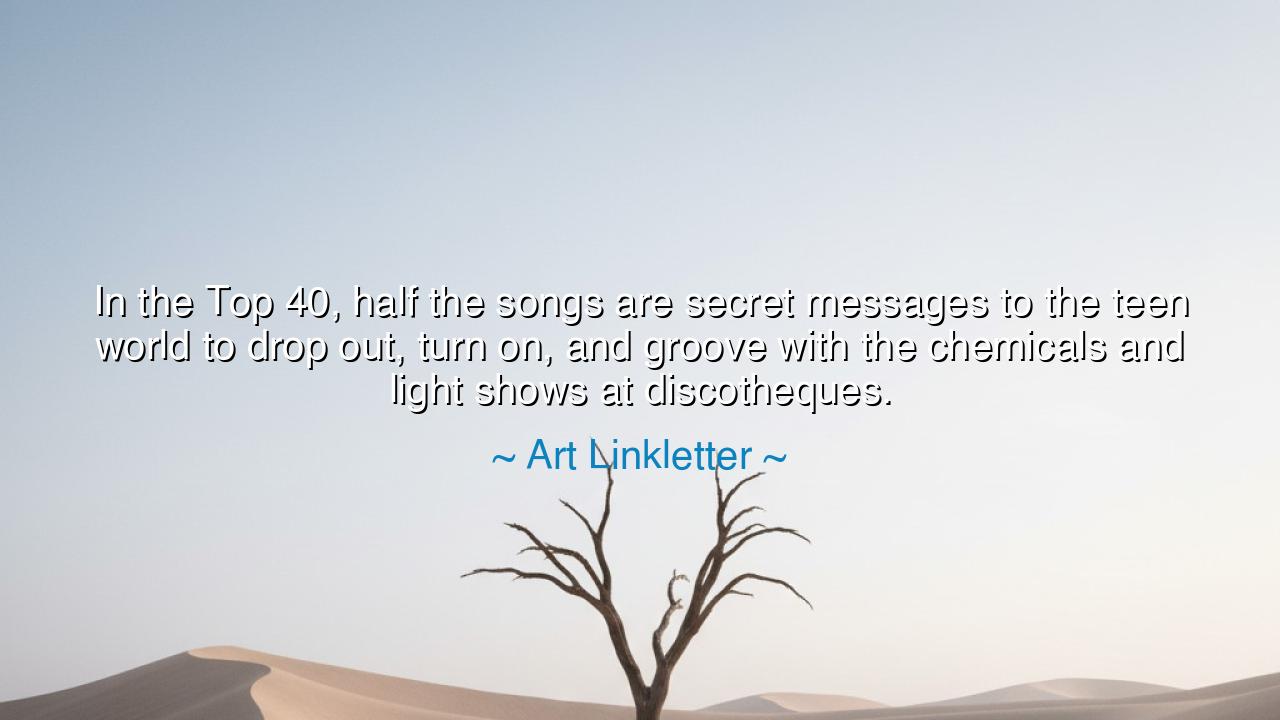
In the Top 40, half the songs are secret messages to the teen
In the Top 40, half the songs are secret messages to the teen world to drop out, turn on, and groove with the chemicals and light shows at discotheques.






Hearken, children of the ages, to the solemn warning of Art Linkletter, who casts his gaze upon the world of youthful allure and its hidden currents: “In the Top 40, half the songs are secret messages to the teen world to drop out, turn on, and groove with the chemicals and light shows at discotheques.” Within this observation lies a reflection upon the power of culture, the subtle persuasion of entertainment, and the vulnerability of adolescence to messages that stir both imagination and impulse. Linkletter’s words reveal a caution as old as humanity: the young, untested by time, are most susceptible to influences that can shape their character and destiny.
The origin of this statement lies in Linkletter’s role as an observer and chronicler of youth during the mid-20th century, a time when popular music—particularly the Top 40 hits—was not merely melody and rhythm, but a vector of behavioral suggestion. Discotheques, vibrant with light, sound, and movement, became spaces where culture and chemistry intertwined, and songs often carried subtle invitations to abandon convention, to explore sensation, and to seek freedom in ways both exhilarating and perilous. The “secret messages” were encoded in lyrics, tone, and rhythm, shaping the choices, moods, and moral compass of impressionable teens.
Consider the wisdom of the ancients, who understood the influence of spectacle and art upon youth. Plato, in his Republic, warned that poetry and music shape the soul, teaching virtue or vice through rhythm and narrative. Linkletter’s insight echoes this ancient truth: songs are not mere entertainment—they are teachers of desire, attitude, and conduct, and those who wield them subtly guide the minds of the young, who have yet to cultivate the discernment that comes with experience.
History provides a vivid parallel in the cultural upheavals of the 1960s. Teens and young adults flocked to rock concerts, festivals, and discotheques, exploring both musical innovation and the expanding boundaries of social freedom. Figures like Timothy Leary, advocating “turn on, tune in, drop out,” demonstrate the confluence of culture, chemical experimentation, and youthful rebellion. Linkletter’s words remind us that such messages were not always explicit; often, they were encoded in melody, beat, and communal experience, subtly encouraging behavior beyond the watchful eyes of guardians and elders.
This quote also reveals the psychological potency of music and rhythm. Adolescents, their emotions amplified and their judgment still forming, are uniquely sensitive to repetition, melody, and social reinforcement. A song becomes a call to communal action, a secret code that validates exploration, risk, and rebellion. Linkletter’s observation is thus not merely critique, but a recognition of the power of cultural artifacts to shape norms, desires, and identities, especially when the audience is impressionable and seeking belonging.
From this reflection emerges a lesson of enduring importance: culture is never neutral, and the forces that shape youth require awareness and guidance. The allure of music, entertainment, and spectacle can uplift or mislead, depending upon the discernment of the listener. The ancients would counsel vigilance, moderation, and mentorship: the young must be taught to discern messages hidden within pleasure, to temper desire with judgment, and to seek experiences that cultivate virtue rather than indulgence.
Practical guidance flows from this insight. First, cultivate critical awareness of cultural media, observing the implicit messages in music, lyrics, and visual spectacle. Second, engage in dialogue with mentors, guardians, or peers, questioning the purpose and effect of the cultural currents one encounters. Third, provide constructive alternatives, encouraging creative expression, athletic engagement, and intellectual exploration as outlets for energy and curiosity. Fourth, model discernment and restraint, demonstrating that pleasure and culture need not be paths to excess or harm. Finally, foster the ability to resist subtle persuasion, teaching that the freedom of choice is strengthened by reflection, courage, and self-knowledge.
Thus, let Art Linkletter’s words echo through the corridors of time: the Top 40, the discotheque, and the music of youth carry power far beyond the ear. They are teachers, guides, and sometimes tempters, shaping the moral and emotional landscape of the young. By cultivating awareness, critical thought, and guidance, we honor the vulnerability and potential of adolescence, turning the power of culture toward wisdom, growth, and virtue, rather than chaos, indulgence, or fleeting pleasure. In this lies the timeless truth: to understand influence is to master choice, and to master choice is to preserve the integrity of self across the storms of youth.






AAdministratorAdministrator
Welcome, honored guests. Please leave a comment, we will respond soon